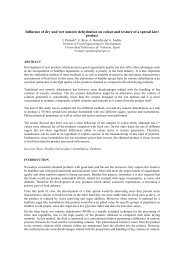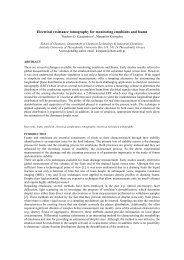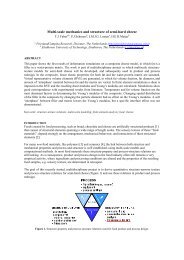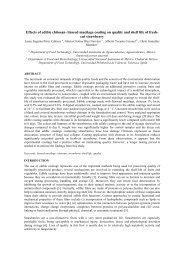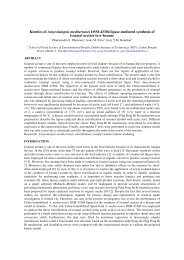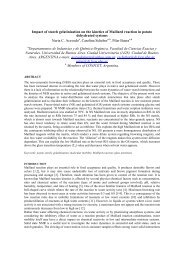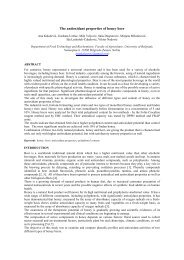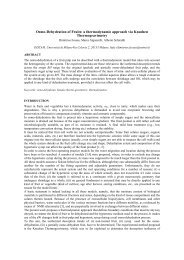Process Optimisation of Egg Replacer in Sponge Cake Baking
Process Optimisation of Egg Replacer in Sponge Cake Baking
Process Optimisation of Egg Replacer in Sponge Cake Baking
You also want an ePaper? Increase the reach of your titles
YUMPU automatically turns print PDFs into web optimized ePapers that Google loves.
<strong>Process</strong> <strong>Optimisation</strong> <strong>of</strong> <strong>Egg</strong> <strong>Replacer</strong> <strong>in</strong> <strong>Sponge</strong> <strong>Cake</strong> Bak<strong>in</strong>g<br />
Levan Mai a , Tom Norton b , Weili Li a , Brijesh Tiwari a , Charles Brennan a<br />
a Department <strong>of</strong> Food, Manchester Metropolitan University, Holl<strong>in</strong>gs Faculty, Manchester, UK<br />
b Department <strong>of</strong> Eng<strong>in</strong>eer<strong>in</strong>g, Harper-Adams University College, Shropshire, UK<br />
INTRODUCTION<br />
Heath risk associated with the consumption <strong>of</strong> eggs [1] and consumer preference for vegan diet<br />
had lead researchers to <strong>in</strong>vestigate for egg replacers. The partial or total substitution <strong>of</strong> egg <strong>in</strong><br />
cake formulation appears <strong>in</strong>terest<strong>in</strong>g for people who suffer from cholesterol-diseases. The<br />
replacement <strong>of</strong> egg <strong>in</strong> bakery products such as cake is a challeng<strong>in</strong>g task. Presence <strong>of</strong> egg<br />
white prote<strong>in</strong>s plays a significant role <strong>in</strong> foam formation by allow<strong>in</strong>g the <strong>in</strong>corporation <strong>of</strong> large<br />
volumes <strong>of</strong> air <strong>in</strong>to the batter. Subsequent bak<strong>in</strong>g allows trapped air bubbles to expand lead<strong>in</strong>g<br />
to an <strong>in</strong>crease <strong>in</strong> the volume <strong>of</strong> cake after the coagulation <strong>of</strong> egg prote<strong>in</strong>s dur<strong>in</strong>g bak<strong>in</strong>g [2].<br />
Response surface methodology has previously been used to optimise the process<strong>in</strong>g variables<br />
<strong>in</strong> partial or complete replacement <strong>of</strong> egg <strong>in</strong> cakes. For example, Arozarena et al., [3] employed<br />
central composite design to <strong>in</strong>vestigate the effect <strong>of</strong> several <strong>in</strong>gredients on physicochemical<br />
characteristics <strong>of</strong> lup<strong>in</strong>e. The objective <strong>of</strong> this study was to optimise the bak<strong>in</strong>g process<br />
parameters such as mix<strong>in</strong>g time, bak<strong>in</strong>g time and temperature us<strong>in</strong>g Box-Benhken design.<br />
MATERIALS & METHODS<br />
<strong>Cake</strong>s were prepared us<strong>in</strong>g a standard recipe as outl<strong>in</strong>ed by AACC. <strong>Cake</strong>s samples were<br />
analysed for texture, colour values (L*,a*,b*), specific volume, specific gravity, symmetry <strong>of</strong><br />
cake samples as per AACC. The effects <strong>of</strong> the three <strong>in</strong>dependent process<strong>in</strong>g parameters on<br />
quality parameters were <strong>in</strong>vestigated us<strong>in</strong>g Box-Behnken designs. The <strong>in</strong>dependent variables<br />
were; X 1 (4 – 10 m<strong>in</strong>), X 2 (160 – 200 o C) and X 3 (10 – 30 m<strong>in</strong>). Experimental data from the<br />
Box-Behnken design was analysed and fitted to a second-order polynomial model.<br />
3<br />
3<br />
2<br />
Y X X X X<br />
[1]<br />
<br />
<br />
<br />
0 i i<br />
ii i<br />
<br />
ij<br />
i1<br />
i1<br />
i ji1<br />
where Y is the predicted response, β 0 , β i , β ii and β ij are the <strong>in</strong>tercept, l<strong>in</strong>ear, quadratic and cross<br />
product coefficients. X i and X j are <strong>in</strong>dependent variables.<br />
i<br />
j<br />
RESULTS & DISCUSSION<br />
SG, texture, L*, a*, b* and Sym responses fluctuated between 0.74 to 0.64, 194.06 to 300.12,<br />
50.03 to 77.30, 4.04 to 15.60, 16.86 to 33.64 and 0.15 to 1.80 respectively. The models<br />
presented showed high regression coefficients (R 2 > 0.80) for SG and colour values (L*, a*,b*)<br />
whereas low regression coefficients (R 2 = 0.47) laws observed for Sym <strong>of</strong> the cakes. The<br />
predicted models were found to be significant with p values
a) b)<br />
200<br />
0.68<br />
0.68<br />
0.67<br />
0.70<br />
190<br />
180<br />
0.71<br />
0.68<br />
170<br />
Bak<strong>in</strong>g temperature ( o C)<br />
200<br />
190<br />
180<br />
170<br />
221<br />
213<br />
213<br />
229<br />
245<br />
0.67<br />
0.66<br />
160<br />
10<br />
12<br />
0.69<br />
14<br />
16<br />
18<br />
20<br />
Figure 1. Contour plots show<strong>in</strong>g the effect <strong>of</strong> bak<strong>in</strong>g temperature ( o C) and bak<strong>in</strong>g time (m<strong>in</strong>) at mix<strong>in</strong>g<br />
time <strong>of</strong> 7 m<strong>in</strong> on specific gravity (a), texture (b) <strong>of</strong> cakes.<br />
160<br />
10<br />
12<br />
205<br />
14<br />
16<br />
221<br />
18<br />
237<br />
20<br />
Both l<strong>in</strong>ear and quadratic models were significant (p



